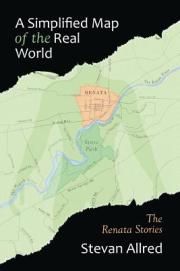 Stevan Allred
Stevan Allred
Illustrated by Laurie Paus
Forest Avenue Press ($18)
by Jason Cook
Story cycles are often dedicated to exploring a place, the setting as the dominant character exerting tidal influences on the stories taking place within in it. The town of Renata in Stevan Allred’s A Simplified Map of the Real World, however, is just a place: some forests and farms, roads and where they lead, mountain lakes and submerged cars, houses and the lives lived inside them. It’s the people who bring Renata alive, engaged as they are in age-old amorphous feuds, youthful adventures, and acts of vengeance.
Allred has an eye for those sweet moments, the glimmers of hope and uplift that come by as rarely in fiction as they do in life. In “The Idjit’s Guide to Intuitive Mastery of Newtonian Physics,” two brothers rig a car for a high-flying stunt into a mountain lake. The town’s residents gather to watch, including Sheriff Larrabee, who intends to put a stop to it. Instead, the sheriff watches the victory because “if a man couldn’t raise his middle finger and shake it in the face of gravity every once in a while then there wasn’t much point to being alive.” Allred achieves another feat of strange beauty with “Doubling Down” and its protagonist Brooke, a self-absorbed, crass, reckless stripper who survives a horrific accident in the opening pages. We follow her home after her injury, where her own deficiencies are matched by those of her middle-class respectable family. While she never reveals a single redemptive character trait, there is something triumphant in the senseless, dangerous act of destruction at the end, her own middle finger.
The finest example of this, and A Simplified Map of the Real World’s strongest piece, is “Vortex.” Lenny is a closeted gay man in 1970, the setting for a particular kind of tragedy. At an outdoor rock concert, he meets another man and they venture into the woods. Everything seems to lead to the unfortunate societal revelation and its fallout. However, in the last line, Allred turns the table, letting the story trail off with a note of hope and brightness.
The sensitive and compassionate characterizations in these stories are fueled by prose that is both strong and delicate. Characters stumble into uplifting epiphanies, those soft moments when possibilities unfurl just a little: “The world was vast, and if you only knew how, you could get there from here, and bring back artifacts that proved you knew the way.” Following these moments with a picture of a bleaker tomorrow is an easy trick which Allred usually denies himself. This Simplified Map of the Real World shows the emptiness of lives unloved and existing in the wreckage of abandoned dreams, but also points the way to beauty and celebrates those finer moments about which we sometimes seem to have forgotten how to speak.

